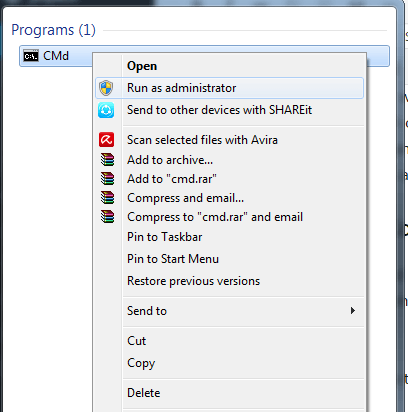Use the CMD command to remove viruses on Windows computers
Today viruses are becoming more "cunning", they can "penetrate" users' computers through Internet browsers, USB devices and even through the installation of applications. and software.
Once it has penetrated the user's computer, the virus can cause a variety of problems such as slowing down the computer operating system, even some viruses can "steal" user data. .
There are many ways to get rid of hateful viruses on your computer, users can use programs, anti-virus software, . Also, many unknown users can use CMD command can also Remove virus on Windows computer.

Remove the virus on your computer using CMD
In fact, the Command prompt is a utility program that is used to access all system files. Also you can use CMD to remove viruses on your computer.
To remove the virus on your computer using Command Prompt, follow the steps below:
First click on Start, then enter CMD in the Search box, right-click the CMD icon and select Run as admininstrator.

Now the screen of the Command Prompt window appears, the next step is to select the drive you want to remove the virus from.

If you want to remove the virus on drive D, enter the following command into the Command Prompt and press Enter:
dir D: attrib -s -h / s / d *. *

Note:
If you want to remove the virus on another drive, replace drive D with the drive name you want to remove the virus from.
Enter dir to display all content and files on your drive. At this point the Command Prompt will scan the selected drive and load all the files on your drive.

If you see strange .exe files or any autorun.inf files, rename these files using the command:
(rename filename.extension new filename)
In addition, you can refer to the video tutorial on steps to remove the virus by CMD below:
Refer to some of the following articles:
- 9 most effective antivirus software for Windows today
- Windows Defender is disabled or inactive, this is a fix
- 9 tips to protect your computer safely from virus attacks
Good luck!
You should read it
- How to remove viruses, malware on Mac
- How to remove viruses on your computer - Summary of the most effective way to remove viruses on your computer
- How to remove viruses hidden on USB
- No need to use an antivirus program, this is how to get rid of the virus on your computer
- The most effective way to remove viruses on your phone
- Completely remove URL Mal Virus - http://107.170.47.181
- Remove viruses from Windows PC with Ubuntu Live USB
- Limiting the spread of Virus, Trojan manually on Windows
May be interested
- How to Locate Viruses Using the Attrib Command
 this wikihow teaches you how to find and remove a virus that you know by name from your windows computer. to do so, you'll use the command prompt program. open the start menu. click the windows logo in the bottom-left corner of the screen,...
this wikihow teaches you how to find and remove a virus that you know by name from your windows computer. to do so, you'll use the command prompt program. open the start menu. click the windows logo in the bottom-left corner of the screen,... - Set command in Windows
 the set command helps show, set or remove cmd.exe environment variables.
the set command helps show, set or remove cmd.exe environment variables. - How to scan and repair computers infected with viruses or malware
 if windows is infected with a virus or malware, running an antivirus program from within windows is often not very effective. you can find and remove viruses as well as malware by scanning from outside windows.
if windows is infected with a virus or malware, running an antivirus program from within windows is often not very effective. you can find and remove viruses as well as malware by scanning from outside windows. - Completely remove URL Mal Virus - http://107.170.47.181
 url: mal is one of the most dangerous dns related to advertising platform. it has the address is http://107.170.47.181. url: mal is created by free software from unwanted programs (pup). url: mal appears on your computer, then your computer will appear a series of ads. its purpose is to trick users into clicking on links to make a profit.
url: mal is one of the most dangerous dns related to advertising platform. it has the address is http://107.170.47.181. url: mal is created by free software from unwanted programs (pup). url: mal appears on your computer, then your computer will appear a series of ads. its purpose is to trick users into clicking on links to make a profit. - How to Open Command Prompt on Windows
 today's tipsmake will show you how to open the command prompt program on windows. there are many ways to do it, from as simple as searching the start menu to using the run command. however, you should remember, some computers (such as school computers) cannot run command prompt due to restrictions.
today's tipsmake will show you how to open the command prompt program on windows. there are many ways to do it, from as simple as searching the start menu to using the run command. however, you should remember, some computers (such as school computers) cannot run command prompt due to restrictions. - Limiting the spread of Virus, Trojan manually on Windows
 in addition to using anti-virus software to kill trojan viruses, you can still limit the spread of viruses, trojans without installing any additional software on the system.
in addition to using anti-virus software to kill trojan viruses, you can still limit the spread of viruses, trojans without installing any additional software on the system. - How to delete, remove software on Windows 10 computers
 how to delete, remove software on windows 10 computers. below are ways to delete, remove software on windows 10 computers, please follow along. method 1: uninstall software on windows 10 using apps in settings. step 1: select the window icon (start menu) and then select
how to delete, remove software on windows 10 computers. below are ways to delete, remove software on windows 10 computers, please follow along. method 1: uninstall software on windows 10 using apps in settings. step 1: select the window icon (start menu) and then select - Remove viruses, trojans on Windows 7 manually
 this article i will show you how to remove viruses, trojans manually on windows 7 operating system in a simple way.
this article i will show you how to remove viruses, trojans manually on windows 7 operating system in a simple way. - How to Remove Viruses and Create Shortcuts on Windows
 if you insert a usb or sd memory card into your computer and discover that there is no more data or only shortcuts, it is likely that your storage device is infected with a virus. luckily, your files are still there, just hidden. with just a few commands and free tools, you'll be able to restore data and remove viruses from your drive and computer.
if you insert a usb or sd memory card into your computer and discover that there is no more data or only shortcuts, it is likely that your storage device is infected with a virus. luckily, your files are still there, just hidden. with just a few commands and free tools, you'll be able to restore data and remove viruses from your drive and computer. - How to Open the Command Prompt in Windows
 this wikihow teaches you how to open the command prompt program in windows. there are several ways to do this, from simply searching in the start menu to using a run command. keep in mind that some computers, such as school computers, will...
this wikihow teaches you how to open the command prompt program in windows. there are several ways to do this, from simply searching in the start menu to using a run command. keep in mind that some computers, such as school computers, will...










 What to do if your computer has a virus?
What to do if your computer has a virus? 17 clear signs that your computer has been attacked by a virus
17 clear signs that your computer has been attacked by a virus Instructions for removing PUP.Tuto4PC virus
Instructions for removing PUP.Tuto4PC virus How to remove the root virus ExtTag.exe / ExtTags.exe
How to remove the root virus ExtTag.exe / ExtTags.exe Viruses transmitted from smartphones to computers appear in Vietnam
Viruses transmitted from smartphones to computers appear in Vietnam Computer viruses can infect through ... air
Computer viruses can infect through ... air